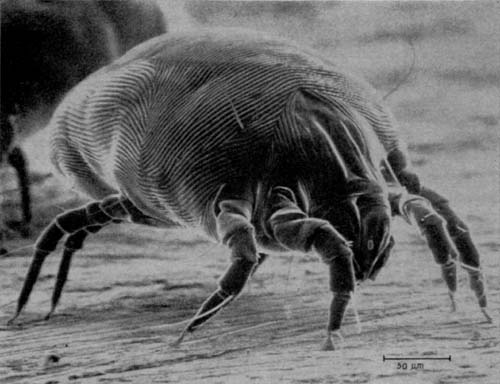Mite Be a Bad Idea

A few millennia ago, in ancient Egypt, King Tutankhamun had an elaborate, gold gilded wooden bed (seen here, now on display at the Cairo Museum); it’s one of the earliest known beds, historically. And somewhere since then, for initial reasons lost to antiquity, a rule emerged still in existence today:
Make your bed.
That advice — or, more accurately, command — has probably been spoken by mothers for centuries. A Google search on “how to make a bed” yields nearly half a million results, most of which deal with moving pillows and sheets around, and not with actual carpentry. (One result is a video, 3 minutes and 15 steps long. But it does yield a pretty neatly made bed.) It’s a part of culture — and, a 2004 study suggests, a bad idea, because of household dust mites.
Dust mites are in and of themselves barely noticeable (and innocuous) — they measure less than half a millimeter in length. The tiny arachnids feed off microscopic pieces of discarded human skin, which makes up a lot of what we think of as household dust. But dust mite feces are not as harmless as the creatures themselves. It can cause allergic and/or asthmatic reactions in people — in fact, dust mite excrement is one of the most allergy-inducing substances out there, perhaps affecting 1.2 billionpeople worldwide.
The mites thrive in warm, relatively damp environments. Beds seem to fit the bill: an occupied bed gets both body heat and sweat from the people sleeping inside it. But when the morning comes, and the people leave, a lot of the heat and moisture escapes, or so the theory goes. And in January of 2005, the BBC reported of a Kingston University study which found that dust mites prefer made beds for just this reason — making the bed traps some of the heat and dampness inside. As one researcher put it: “Something as simple as leaving a bed unmade during the day can remove moisture from the sheets and mattress so the mites will dehydrate and eventually die.” So it might be a bad idea to make your bed after all.
Sorry, mom.
Bonus fact: Want to see what a drop of seawater looks like up close? Like your bed, it too, has microörganisms in it, as seen here.
From the Archive: Strawberry Bugs: Bugs where you really don’t want them.

Leave a comment